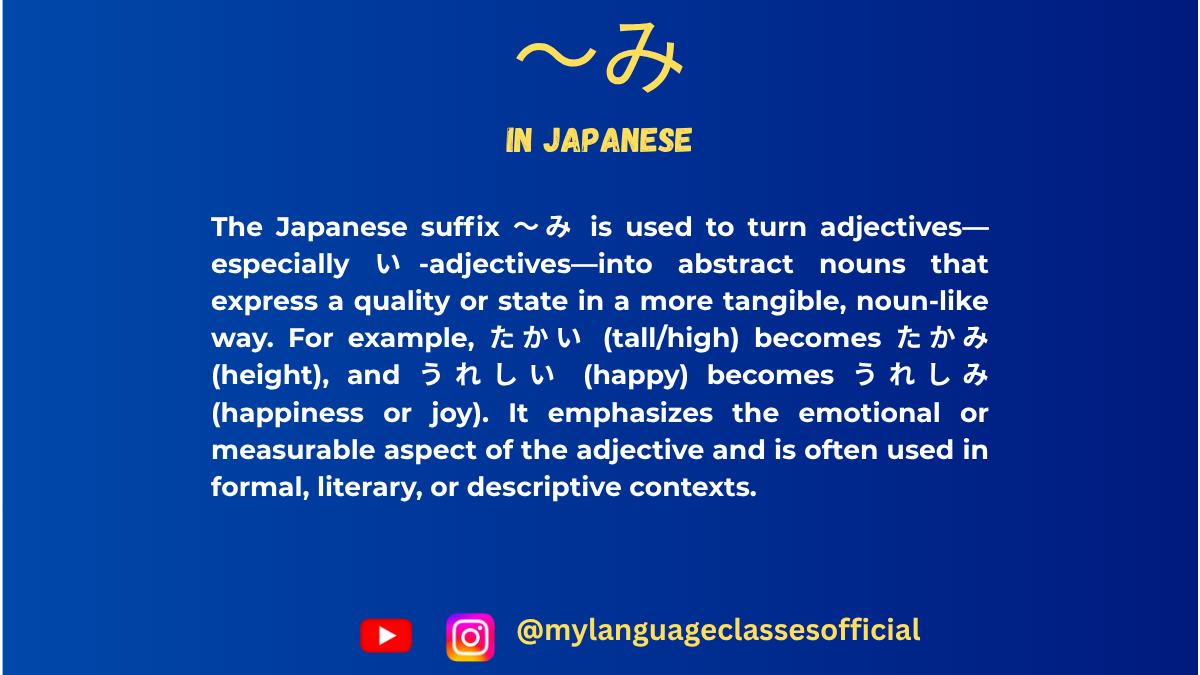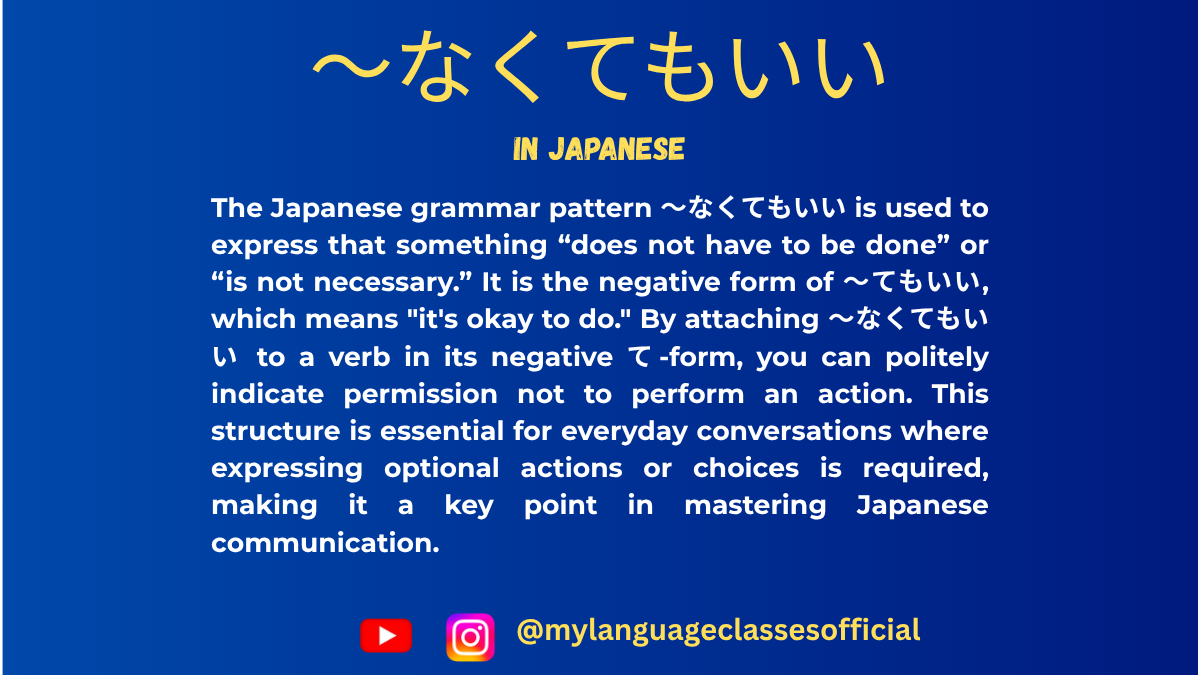Your cart is currently empty!
Tag: Japanese language nuances
-

〜み: The Nominalizer for Adjectives/Verbs | My Language Classes
Understanding 〜み in Japanese
Japanese is a language rich in nuances, and one of its unique features is the use of nominalizers like 〜み. If you’ve ever wondered how to turn adjectives into nouns to express abstract qualities or feelings, 〜み is your go-to tool.
In this blog post, we’ll dive deep into the meaning, formation, and usage of 〜み, along with plenty of examples to help you master this essential grammar point.
What is 〜み?
〜み is a nominalizer used primarily with adjectives (and sometimes verbs) to turn them into nouns. It expresses an abstract quality, state, or feeling associated with the original word. For example, 甘い (amai, sweet) becomes 甘み (amami, sweetness), which refers to the quality of being sweet.
This form is commonly used in everyday Japanese to describe sensations, emotions, or characteristics. It’s a versatile tool that adds depth to your expressions.
Formation of 〜み
1. With Adjectives
To form 〜み with adjectives, remove the final い (if it’s an い-adjective) and add み.
Example:
- 甘い (amai, sweet) → 甘み (amami, sweetness)
- 痛い (itai, painful) → 痛み (itami, pain)
2. With Nouns
Some nouns can also take 〜み to express a related quality or state.
Example:
- 強さ (tsuyosa, strength) → 強み (tsuyomi, strong point)
- 深さ (fukasa, depth) → 深み (fukami, depth/richness)
3. With Verbs
While less common, some verbs can also take 〜み to express a resulting state or quality.
Example:
- 楽しむ (tanoshimu, to enjoy) → 楽しみ (tanoshimi, enjoyment)
- 悲しむ (kanashimu, to grieve) → 悲しみ (kanashimi, sadness)
Usage of 〜み
The 〜み form is used in various situations to describe abstract qualities, emotions, or states. Here are some common scenarios:
- Describing Sensations:
- 甘み (amami, sweetness)
- 苦み (nigami, bitterness)
- Expressing Emotions:
- 悲しみ (kanashimi, sadness)
- 楽しみ (tanoshimi, enjoyment)
- Highlighting Characteristics:
- 強み (tsuyomi, strong point)
- 弱み (yowami, weakness)
- Describing Physical States:
- 痛み (itami, pain)
- 重み (omomi, heaviness)
List of Verbs, Nouns, and Adjectives with 〜み Form
Original Word 〜み Form Example Sentence Romaji English Meaning 甘い (amai, sweet) 甘み (amami, sweetness) この果物は甘みがある。 Kono kudamono wa amami ga aru. This fruit has sweetness. 痛い (itai, painful) 痛み (itami, pain) 彼は痛みを感じた。 Kare wa itami o kanjita. He felt pain. 強い (tsuyoi, strong) 強み (tsuyomi, strong point) 彼の強みは忍耐力だ。 Kare no tsuyomi wa nintairyoku da. His strong point is patience. 深い (fukai, deep) 深み (fukami, depth) この話には深みがある。 Kono hanashi ni wa fukami ga aru. This story has depth. 悲しむ (kanashimu, to grieve) 悲しみ (kanashimi, sadness) 彼女の目には悲しみがあった。 Kanojo no me ni wa kanashimi ga atta. There was sadness in her eyes. 楽しむ (tanoshimu, to enjoy) 楽しみ (tanoshimi, enjoyment) 週末の旅行が楽しみだ。 Shuumatsu no ryokou ga tanoshimi da. I’m looking forward to the weekend trip.
More Example Sentences
- この料理は苦みが特徴です。
Romaji: Kono ryouri wa nigami ga tokuchou desu.
English: This dish is characterized by its bitterness. - 彼の言葉には重みがあった。
Romaji: Kare no kotoba ni wa omomi ga atta.
English: His words had weight. - このワインは酸みがきいている。
Romaji: Kono wain wa suami ga kiite iru.
English: This wine has a nice acidity. - 彼女の笑顔には温かみがある。
Romaji: Kanojo no egao ni wa atatakami ga aru.
English: Her smile has warmth. - この絵には深みがある。
Romaji: Kono e ni wa fukami ga aru.
English: This painting has depth. - 彼の強みはリーダーシップです。
Romaji: Kare no tsuyomi wa riidaashippu desu.
English: His strong point is leadership. - このお茶は甘みが少ない。
Romaji: Kono ocha wa amami ga sukunai.
English: This tea has little sweetness. - 彼の目には悲しみが浮かんでいた。
Romaji: Kare no me ni wa kanashimi ga ukande ita.
English: Sadness was visible in his eyes. - この音楽には楽しみがある。
Romaji: Kono ongaku ni wa tanoshimi ga aru.
English: This music has a sense of enjoyment. - 彼は痛みに耐えた。
Romaji: Kare wa itami ni taeta.
English: He endured the pain.
Things to Keep in Mind
- Not All Adjectives Can Take 〜み: Some adjectives, like 新しい (atarashii, new), don’t naturally take 〜み.
- Abstract Nature: 〜み is used for abstract qualities, not concrete objects.
- Context Matters: The meaning of 〜み can vary depending on the context.
- Less Common with Verbs: While possible, 〜み is rarely used with verbs compared to adjectives.
Fill in the Blanks
- このケーキは______がある。 (甘い)
- 彼の______は優しさです。 (強い)
- このコーヒーは______が強い。 (苦い)
- 彼女の声には______があった。 (暖かい)
- この小説には______がある。 (深い)
- 彼は______に耐えた。 (痛い)
- このワインは______がきいている。 (すあい)
- 彼の目には______が浮かんでいた。 (悲しい)
- 週末の旅行が______だ。 (楽しい)
- この料理は______が特徴です。 (苦い)
Answers:
- 甘み
- 強み
- 苦み
- 温かみ
- 深み
- 痛み
- 酸み
- 悲しみ
- 楽しみ
- 苦み
Conclusion
Mastering 〜み is a great way to add depth and nuance to your Japanese. Whether you’re describing emotions, sensations, or characteristics, this nominalizer is a powerful tool in your language arsenal. Practice the examples, try the fill-in-the-blanks, and soon you’ll be using 〜み like a native speaker!
If you enjoyed this lesson, be sure to check out more posts like this on my blog at My Language Classes. Don’t forget to subscribe my YouTube channel and follow me on Instagram for the latest language learning tips and lessons. Leave a comment below to share your thoughts, or ask any questions you have about nouns.
Happy learning! 😊

